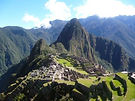PERU INFO
Home > About Peru > Economy > Mining
About Peru
Peru
Mineral industry of Peru
It is the first economic activity of Peru with nearly 60% of foreign exchange earnings in the country. Most of the deposits are located in the Cordillera of the Andes.
Silver
3rd world producer - Peru currently produces almost 3,400 tonnes of silver annually, 11% of the world production, 3rd producer after Mexico and China.
Zinc
2nd world producer, with 1,300 T in 2019, Peru produces nearly 15% of the world production, 2rd producer after China.
Copper
2nd world producer, with 2,2 million t, 8% of world production, after Chile (5,7 million t) and followed by China (1,7 million t).
Tin
3rd world producer after China and Indonesia - 25,000 t in 2020, .
Lead
4th world producer, with 240,000 T (almost 10% of the world production), after China (1'320,000 T), Australia (640,000 t) and USA (430,000 t).
Molybdenum
4th world producer, with 32,000 t, after USA, China and Chile.
Gold
8th largest producer Everyone knows that the gold and silver of the Incas enriched Spain and revitalized the European economy of the 16th century through large-scale looting. Fortunately, Peru remains today one of the world's largest producers of precious metals and the 8th in gold with 128 tons in 2020, behind China (380 t), Australia (320 t), Russia (300 t), the United States (190 t), Canada (170 t), the Gana (140 t) and Indonesia (130 t).
Other important mineral production in Peru are iron and cadmium.
Petroleum
Peru does not produce enough petroleum for domestic consumption.
Gas
In 1987 a giant gas field was discovered in Camisea (Amazon rainforest, department of Cusco). But the exploitation of this treasure becomes reality only in 2004.
Camisea is radically changing the energy matrix in Peru, allowing to change the use of contaminating and expensive fuels, with one cleaner and cheaper, the natural gas.
This change favors the consumer directly, transforming their vehicle to run on gas as have the vast majority of taxis and recently the gas is coming to homes.
The industry also takes advantage of the benefits of gas and has directly and indirectly created thousands of jobs in the country.
Several neighboring countries are interested in importing Peruvian gas. In 2008, Peru has built a gas liquefaction plant at 150 km south of Lima to export this new wealth.
Energy
Electricity in Peru comes from 2 sources:
65% hydraulic
35% gas








